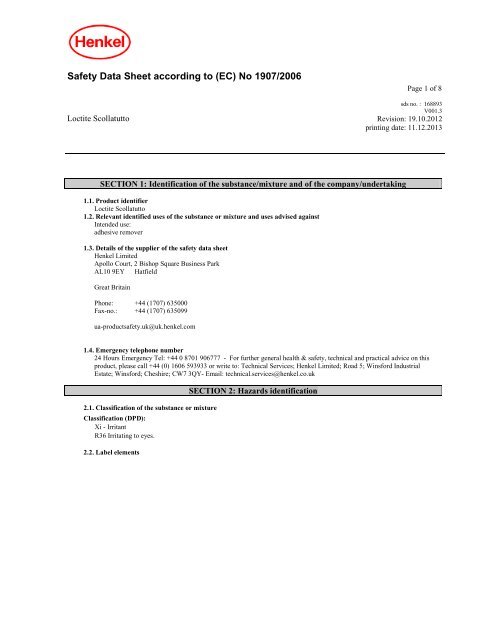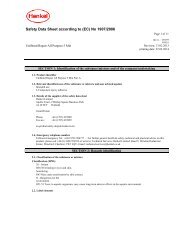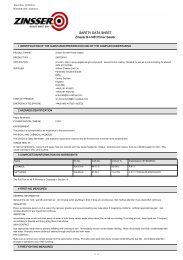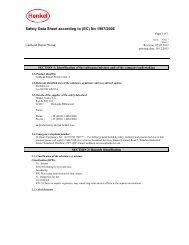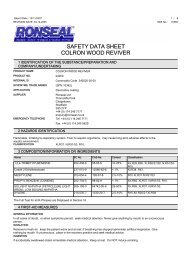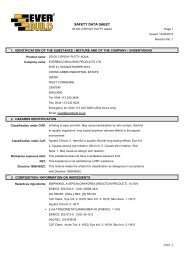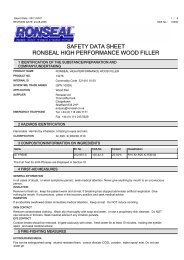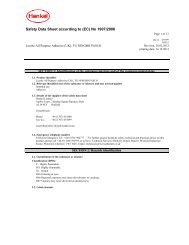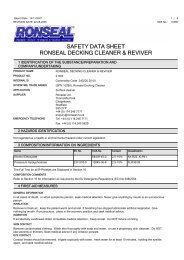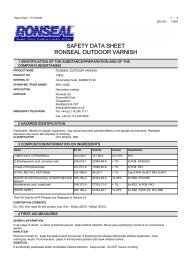SAFETY DATA SHEET LOCTITE GLUE REMOVER GEL - Toolbank
SAFETY DATA SHEET LOCTITE GLUE REMOVER GEL - Toolbank
SAFETY DATA SHEET LOCTITE GLUE REMOVER GEL - Toolbank
You also want an ePaper? Increase the reach of your titles
YUMPU automatically turns print PDFs into web optimized ePapers that Google loves.
MSDS-No.: 168893V001.3Loctite Scollatutto Page 3 of 8Inhalation:Move to fresh air, consult doctor if complaint persists.Skin contact:Rinse with running water and soap. Skin care. Remove contaminated clothes immediately.Eye contact:Immediately flush eyes with soft jet of water or eye rinse solution for at least 5 minutes. If pains remains (intensive smarting,sensivity to light, visual disturbance) continue flushing and contact/seek doctor or hospital.Ingestion:Rinse mouth and throat. Drink 1-2 glasses of water. Seek medical advice.4.2. Most important symptoms and effects, both acute and delayedEYE: Irritation, conjunctivitis.4.3. Indication of any immediate medical attention and special treatment neededSee section: Description of first aid measuresSECTION 5: Firefighting measures5.1. Extinguishing mediaSuitable extinguishing media:carbon dioxide, foam, powder, water spray jet, fine water sprayExtinguishing media which must not be used for safety reasons:High pressure waterjet5.2. Special hazards arising from the substance or mixtureIn the event of a fire, carbon monoxide (CO) and carbon dioxide (CO2) can be released.5.3. Advice for firefightersWear protective equipment.Wear self-contained breathing apparatus.Additional information:Cool endangered containers with water spray jet.SECTION 6: Accidental release measures6.1. Personal precautions, protective equipment and emergency proceduresWear protective equipment.Danger of slipping on spilled product.Avoid contact with skin and eyes.6.2. Environmental precautionsDo not empty into drains / surface water / ground water.6.3. Methods and material for containment and cleaning upDispose of contaminated material as waste according to Chapter 13.Remove with liquid-absorbing material (sand, peat, sawdust).6.4. Reference to other sectionsSee advice in chapter 87.1. Precautions for safe handlingAvoid skin and eye contact.Ensure that workrooms are adequately ventilated.SECTION 7: Handling and storage
MSDS-No.: 168893V001.3Loctite Scollatutto Page 4 of 8Hygiene measures:Wash hands before work breaks and after finishing work.Do not eat, drink or smoke while working.7.2. Conditions for safe storage, including any incompatibilitiesStore in a cool, well-ventilated place.Keep away from heat and direct sunlight.Ensure adequate ventilation.Keep only in the original container.Keep container tightly sealed.Temperatures between + 10 °C and + 25 °CDo not store together with food or other consumables (coffee, tea, tobacco, etc.).7.3. Specific end use(s)adhesive removerSECTION 8: Exposure controls/personal protection8.1. Control parametersValid forGreat BritainNonePredicted No-Effect Concentration (PNEC):Name on listPropylene carbonate108-32-7Propylene carbonate108-32-7Propylene carbonate108-32-7Propylene carbonate108-32-7Propylene carbonate108-32-7EnvironmentalCompartmentaqua (marinewater)aqua(freshwater)STPaqua(intermittentreleases)soilExposureperiodValuemg/l ppm mg/kg others0,09 mg/L0,9 mg/L7400 mg/L9 mg/L0,81 mg/kgRemarks
MSDS-No.: 168893V001.3Loctite Scollatutto Page 5 of 8Derived No-Effect Level (DNEL):Name on listPropylene carbonate108-32-7Propylene carbonate108-32-7Propylene carbonate108-32-7Propylene carbonate108-32-7Propylene carbonate108-32-7Propylene carbonate108-32-7Propylene carbonate108-32-7ApplicationAreaRoute ofExposureHealth Effectworker dermal Long termexposure -systemic effectsworker inhalation Long termexposure - localeffectsworker inhalation Long termexposure -systemic effectsgeneral dermal Long termpopulationexposure -systemic effectsgeneralpopulationgeneralpopulationgeneralpopulationinhalationoralinhalationLong termexposure -systemic effectsLong termexposure -systemic effectsLong termexposure - localeffectsExposureTimeValue50 mg/kg bw/day20 mg/m3176 mg/m325 mg/kg bw/day43,5 mg/m325 mg/kg bw/day10 mg/m3RemarksBiological Exposure Indices:8.2. Exposure controls:Respiratory protection:Suitable breathing mask when there is inadequate ventilation.Combination filter: ABEKPThis recommendation should be matched to local conditions.Hand protection:In the case of longer contact protective gloves made from nitrile rubber are recommended according to EN 374.Perforation time > 240 minutesmaterial thickness > 0.1 mmIn the case of longer and repeated contact please note that in practice the penetration times may be considerably shorter thanthose determined according to EN 374. The protective gloves must always be checked for their suitability for use at thespecific workplace (e.g. mechanical and thermal stress, product compatibility, antistatic effects, etc.). The gloves must bereplaced immediately at the first signs of wear and tear. The information provided by the manufacturers and given in therelevant trade association regulations for industrial safety must always be observed. We recommend that a hand care plan isdrawn up in cooperation with a glove manufacturer and the trade association in accordance with the local operatingconditions.Eye protection:Goggles which can be tightly sealed.Skin protection:Suitable protective clothingSECTION 9: Physical and chemical properties9.1. Information on basic physical and chemical propertiesAppearancegelgel-likecolourless toyellowishOdorMildpHInitial boiling pointFlash pointDecomposition temperatureNo data available / Not applicableNo data available / Not applicable> 123 °C (> 253.4 °F)No data available / Not applicable
MSDS-No.: 168893V001.3Loctite Scollatutto Page 6 of 8Vapour pressure(20 °C (68 °F))Density(20 °C (68 °F))Bulk densityViscosityViscosity (kinematic)Explosive propertiesSolubility (qualitative)(Solvent: Water)Solubility (qualitative)(Solvent: Acetone)Solidification temperatureMelting pointFlammabilityAuto-ignition temperatureExplosive limitsPartition coefficient: n-octanol/waterEvaporation rateVapor densityOxidising properties0,14 mbar1,209 g/cm3No data available / Not applicableNo data available / Not applicableNo data available / Not applicableNo data available / Not applicableSlightPartially solubleNo data available / Not applicableNo data available / Not applicableNo data available / Not applicableNo data available / Not applicableNo data available / Not applicableNo data available / Not applicableNo data available / Not applicableNo data available / Not applicableNo data available / Not applicable9.2. Other informationNo data available / Not applicable10.1. ReactivityNone if used for intended purpose.10.2. Chemical stabilityStable under recommended storage conditions.10.3. Possibility of hazardous reactionsSee section reactivity10.4. Conditions to avoidNone if used for intended purpose.10.5. Incompatible materialsNone if used properly.10.6. Hazardous decomposition productsNone knownSECTION 10: Stability and reactivity11.1. Information on toxicological effectsSECTION 11: Toxicological informationGeneral toxicological information:The preparation is classified based on the conventional method outlined in Article 6(1)(a) of Directive 1999/45/EC. Relevantavailable health/ecological information for the substances listed under Section 3 is provided in the following.Oral toxicity:LD50 > 5000 mg/kg body weightInhalative toxicity:The toxicity of the product is due to its narcotic effect after inhalation.In the event of protracted or repeated exposure, damage to health cannot be excluded.Eye irritation:Primary eye irritation: irritating
MSDS-No.: 168893V001.3Loctite Scollatutto Page 7 of 8Acute toxicity:Hazardous componentsCAS-No.Propylene carbonate108-32-7ValuetypeLD50LD50Value> 5.000 mg/kg> 3.000 mg/kgRoute ofapplicationoraldermalExposuretimeSpeciesratrabbitMethodGerm cell mutagenicity:Hazardous componentsCAS-No.Propylene carbonate108-32-7Propylene carbonate108-32-7Repeated dose toxicityResult Type of study /Route ofadministrationnegative bacterial reversemutation assay (e.gAmes test)Metabolicactivation /Exposure timewith and withoutSpeciesnegative intraperitoneal mouseMethodHazardous componentsCAS-No.Propylene carbonate108-32-7Propylene carbonate108-32-7ResultNOAEL=5.000mg/kgRoute ofapplicationExposure time /Frequency oftreatmentSpeciesMethodoral: gavage 90 days 5 days/week rat OECD Guideline 408(Repeated Dose 90-Day OralToxicity in Rodents)NOAEL=0,1 mg/l inhalation 14 weeks (93 days) 6hours/ day ; 5days/weekratSECTION 12: Ecological informationGeneral ecological information:The preparation is classified based on the conventional method outlined in Article 6(1)(a) of Directive 1999/45/EC. Relevantavailable health/ecological information for the substances listed under Section 3 is provided in the following.Do not empty into drains, soil or bodies of water.12.1. ToxicityHazardous componentsCAS-No.Propylene carbonate108-32-7Propylene carbonate108-32-7Propylene carbonate108-32-7ValuetypeValueAcuteToxicityStudyExposuretimeSpeciesLC50 5.300 mg/l Fish 96 h Leuciscus idusMethodEC50 > 500 mg/l Daphnia 48 h Daphnia magna OECD Guideline202 (Daphnia sp.AcuteImmobilisationTest)EC50 > 900 mg/l Algae 72 h Scenedesmus subspicatus (newname: Desmodesmussubspicatus)OECD Guideline201 (Alga, GrowthInhibition Test)12.2. Persistence and degradabilityHazardous componentsCAS-No.Propylene carbonate108-32-7ResultRoute ofapplicationDegradability Methodaerobic 98 % OECD Guideline 301 E (Readybiodegradability: Modified OECDScreening Test)12.3. Bioaccumulative potential / 12.4. Mobility in soilHazardous componentsCAS-No.Propylene carbonate108-32-7LogKow Bioconcentrationfactor (BCF)-0,41ExposuretimeSpecies Temperature Method
MSDS-No.: 168893V001.3Loctite Scollatutto Page 8 of 8SECTION 13: Disposal considerations13.1. Waste treatment methodsProduct disposal:Dispose of waste and residues in accordance with local authority requirements.Disposal of uncleaned packages:Use packages for recycling only when totally empty.Waste code140603SECTION 14: Transport informationGeneral information:Not hazardous according to RID, ADR, ADNR, IMDG, IATA-DGR.SECTION 15: Regulatory information15.1. Safety, health and environmental regulations/legislation specific for the substance or mixtureVOC content0 %(VOCV 814.018 VOC regulationCH)List of ingredients according to Detergents regulation.Propylene carbonateSiloxanes and Silicones, di-Me, reaction products with silicaPropane-1,2-diolPropylene oxide 1,2-SECTION 16: Other informationThe labelling of the product is indicated in Section 2. The full textof all abbreviations indicated by codes in this safety data sheet are as follows:R36 Irritating to eyes.H319 Causes serious eye irritation.Further information:This information is based on our current level of knowledge and relates to the product in the state in which it is delivered. It isintended to describe our products from the point of view of safety requirements and is not intended to guarantee anyparticular properties.


